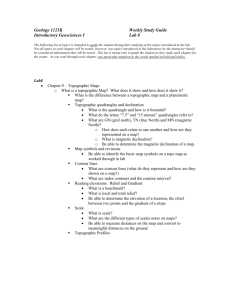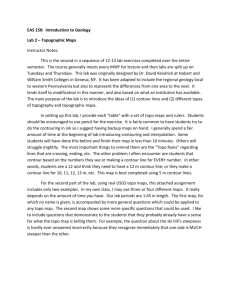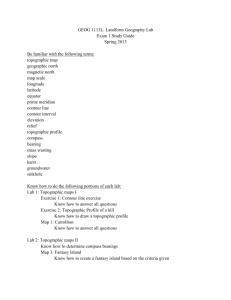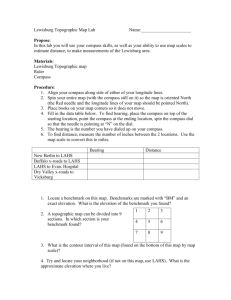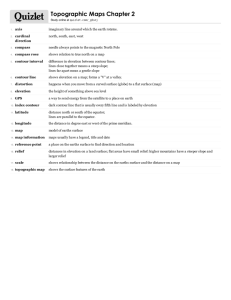Public Land Survey System - High Country Training Center
advertisement
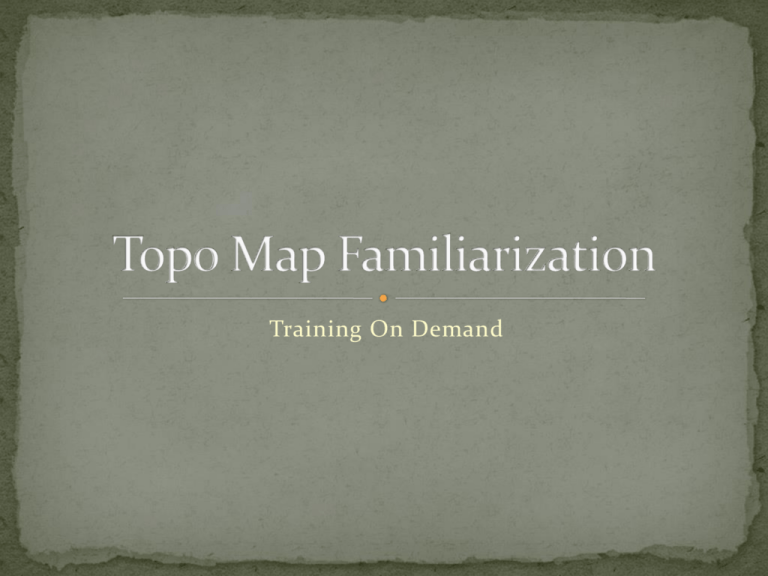
Training On Demand A topographical map is a representation of the Earth, or part of it. The distinctive characteristic of a topographic map is that the shape of the Earth's surface is shown by contour lines. Contours are imaginary lines that join points of equal elevation on the surface of the land above or below a reference surface such as mean sea level. Contours make it possible to measure the height of mountains, depths of the ocean bottom, and steepness of slopes. A topographic map shows more than contours. Maps includes symbols that represent such features as streets, buildings, streams, and woods. These symbols are constantly refined to better relate to the features they represent. A topographic map tells you where things are and how to get to them. In our case, they assist with the location and verification of wildland fires. They show the distance between any two places, and they also show the direction from one point to another. Maps are made to scale; that is, there is a direct relationship, between a unit of measurement on the map and the actual distance on the ground. If 1 inch on the map represents 1 mile (which converts to 63,360 inches) on the ground, the map's scale is 1:63,360. A convenient way of representing map distance is by the use of a graphic scale bar. Most USGS topographic maps have scale bars in the map margin that represents distances on the map in miles, feet, and kilometers. Scale indicates 1:24ooo Map is complete with scale bar to measure distance Contour interval as indicated is 40 ft. Contour lines are a method of depicting the 3- dimensional character of the terrain on a 2dimensional map. Contour are lines drawn on the map represent equal points of height above sea level. On multi-colored maps, contour lines are generally represented in brown. The map legend will indicate the contour interval—the distance in feet (meters, etc.) between each contour line. There will be heavier contour lines every 4th> or 5th contour line that are labeled with the elevation Contour maps give us the grounds topography by the way the lines interact with each other as seen here. Other General Map References Black Blue Brown Green White Red Purple - man-made items water contour lines substantial vegetation little or no vegetation major highways features added to the map since the original survey. Topo maps are used for two main purposes in the fire service: Triangulate the location/ boundaries of a fire Or Identify the location of fire resources in the field Both operations require the use a way to gauge location Latitude/Longitude or the Public Land Survey System defines locations on a map Both require useful knowledge of compass operation. The Public Land Survey System (PLSS) is a way of subdividing and describing land in the United States. All lands in the public domain are subject to subdivision by this rectangular system of surveys, which is regulated by the U.S. Department of the Interior The PLSS is used to divide public domain lands, which are lands owned by the Federal government for the benefit of the citizens of the United States. The original public domain included the land ceded to the Federal Government by the thirteen original States, It encompasses major portions of the land area of 30 southern and western States. Since the original PLSS surveys were completed, much of the land that was originally part of the public domain has been transferred to private ownership. Alabama Alaska Arizona Arkansas California Colorado Florida Idaho Illinois Indiana Iowa Kansas Louisiana • • • • • • • • • • • • • Michigan Minnesota Mississippi Missouri Montana Nebraska Nevada New Mexico North Dakota Oklahoma Ohio Oregon South Dakota • • • • Utah Washington Wisconsin Wyoming Land is divided into 6-mile-square townships, which is the level of information included in the National Atlas. Townships are subdivided into 36 one-mile- square sections. Sections can be further subdivided into quarter sections, quarter-quarter sections, or irregular government lots. Most PLSS surveys begin at an initial point, and townships are surveyed north, south, east, and west from that point. This line is perpendicular to the Principal Meridian. Township N S Range E W Each 6 miles squares Fire in T3N R2E 1 mile square 640 acres Numbered within Township/Range ½ Sections, ¼ Sections divide the section number further Identified by cardinal direction location Ie. “SW ¼ of Section 10”. Fires are now most often located by Latitudinal and Longitudinal coordinates Devices utilizing satellites easily gather coordinates for easy reference Devices must be set to DATUM NAD83 to provide to correct information PLSS acts as a secondary way of indicating the location of a wildland fire. PLSS will make conversion to Latitude and Longitude easy By identifying a fire’s location it can be determined who must be notified Triangulation has become a generic term for the process of measuring to two or more known points to determine - using geometry - the location of an unknown point. To map a fire, firefighters should always triangulate to insure the most accurate possible idea. Align the base plate with an imaginary line between two points on the map. Turn the compass dial until the north lines align with the north lines on the map. Read the bearing set on the compass dial. Hold the compass flat. Sight from an object you can identify on the map Move the dial to match north Remember to account for magnetic declination Read and document the bearing Move to your next landmark Grid North Where the grid on your map is pointing. Since grid lines on the map are all parallel, they never meet in one point. Magnetic North Where the magnetic needle points. These wavy lines depend on iron magma in the earth that changes each year According to the NOAA Frisco CO has a 9⁰ E Magnetic Declination in 2012 9°E means we rotate the base plate's orienting arrow 9° E of 0°/N to compensate for the +9° declination Not a big deal when we are close, but over distance it can lead to significant inaccuracies. Topo maps should indicate a declination chart on them Set the bearing on the compass dial. Lay the long edge of the compass on the known point (where the bearing was taken from). Turn the compass plate so that the north lines align with the north lines on the map. Align the base plate with an imaginary line between two points on the map. Turn the compass dial until the north lines align with the north lines on the map. Read the bearing set on the compass dial. Be aware then of magnetic declination and whether your compass is measuring magnetic north or has been adjusted to grid north. Topo maps and navigation for the purpose of locating wildland fires is not difficult. However, it is a skill that needs to be practiced on a frequent basis to remain proficient Utilize what you have learned and practice your skills Once you are re-familiarized with finding bearings on a map, you will remember how triangulation works Practice these skills as a company
